

The Human Body: Functions, location, shape, diseases of Organs & Organ systems. How the Human Body Works: 50 Free Resources & Open Courseware Classes. It is always helpful to be able to learn more about the human body.
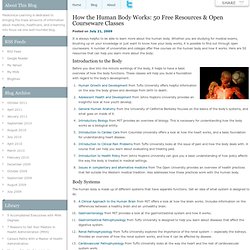
Whether you are studying for medical exams, brushing up on your knowledge or just want to know how your body works, it is possible to find out through open courseware. A number of universities and colleges offer free courses on the human body and how it works. Here are 50 resources that can help you learn more about the body: Human gastrointestinal tract. The human gastrointestinal tract, or GI tract, is an organ system responsible for consuming and digesting foodstuffs, absorbing nutrients, and expelling waste.

The tract consists of the stomach and intestines, and is divided into the upper and lower gastrointestinal tracts.[1] However, by the broadest definition, the GI tract includes all structures between the mouth and the anus.[2] On the other hand, the digestive system is a broader term that includes other structures, including the digestive organs and their accessories.[3] The tract may also be divided into foregut, midgut, and hindgut, reflecting the embryological origin of each segment.
Muscle. Muscle tissues are derived from the mesodermal layer of embryonic germ cells in a process known as myogenesis.

There are three types of muscle, skeletal or striated, cardiac, and smooth. Muscle action can be classified as being either voluntary or involuntary. Cardiac and smooth muscles contract without conscious thought and are termed involuntary, whereas the skeletal muscles contract upon command. [citation needed] Skeletal muscles in turn can be divided into fast and slow twitch fibers. Muscles are predominantly powered by the oxidation of fats and carbohydrates, but anaerobic chemical reactions are also used, particularly by fast twitch fibers.
Human body. Beyond the Brain What goes on within the human skull is more complex and fantastic than anyone imagined.

And scientists are finding ways to delve even deeper into what we know of the mind. Mending Broken Hearts Cheeseburgers, smoking, stress—risk factors for heart disease, a malady reaching global epidemic proportions. Now, discoveries about genetic triggers may help us spot trouble before it starts. Unmasking Skin Equal parts armor, air-conditioning system, and genetic heritage, skin is more than skin-deep.
Master Muscle List Home Page. Spinal cord. Structure[edit] Diagram of the spinal cord showing segments The spinal cord is the main pathway for information connecting the brain and peripheral nervous system.
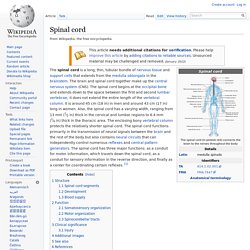
The length of the spinal cord is much shorter than the length of the vertebral column. The human spinal cord extends from the foramen magnum and continues through to the conus medullaris near the second lumbar vertebra, terminating in a fibrous extension known as the filum terminale. It is about 45 cm (18 in) long in men and around 43 cm (17 in) in women, ovoid-shaped, and is enlarged in the cervical and lumbar regions.
Body soul. Skeletal muscle. Skeletal muscle is a form of striated muscle tissue which is under the control of the somatic nervous system; that is to say, it is voluntarily controlled.
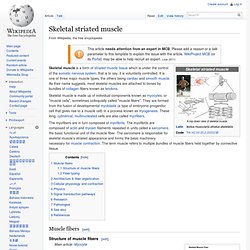
It is one of three major muscle types, the others being cardiac and smooth muscle. As their name suggests, most skeletal muscles are attached to bones by bundles of collagen fibers known as tendons. The myofibers are in turn composed of myofibrils. The myofibrils are composed of actin and myosin filaments repeated in units called a sarcomere, the basic functional unit of the muscle fiber. The sarcomere is responsible for skeletal muscle's striated appearance and forms the basic machinery necessary for muscle contraction.
Muscle fibers[edit] Top 10: Top 10 Body Hacks. Human Anatomy Online. ATLASofANATOMY. Gray's Anatomy of the Human Body. Human Anatomy. Anatomy Arcade. Human Body Systems. Blood pressure. Blood pressure without further specification usually refers to the systemic arterial pressure measured at a person's upper arm and is a measure of the pressure in the brachial artery, the major artery in the upper arm.
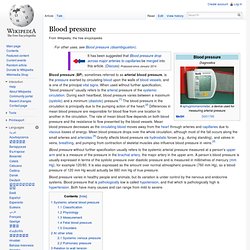
A person’s blood pressure is usually expressed in terms of the systolic pressure over diastolic pressure and is measured in millimetres of mercury (mm Hg), for example 120/80. It is also expressed as the amount over normal atmospheric pressure (760 mm Hg), so a blood pressure of 120 mm Hg would actually be 880 mm Hg of true pressure.
Blood pressure varies in healthy people and animals, but its variation is under control by the nervous and endocrine systems. Blood pressure that is pathologically low is called hypotension, and that which is pathologically high is hypertension. Both have many causes and can range from mild to severe. Systemic arterial blood pressure[edit] Classification[edit] Normal range of blood pressure[edit] Physiology[edit] Some physical factors are: Skeletal muscle. Discovery Health "How Your Heart Works" Everyone knows that the heart is a vital organ.
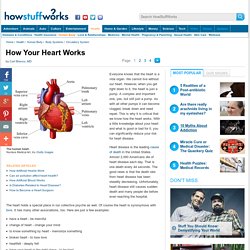
We cannot live without our heart. However, when you get right down to it, the heart is just a pump. A complex and important one, yes, but still just a pump. As with all other pumps it can become clogged, break down and need repair. This is why it is critical that we know how the heart works. Body -Knowledge. Male Body. Urination. Manneken Pis (along with the corresponding female Jeanneke Pis, in limestone) is a bronze sculpture in Brussels, Belgium.

Urination is the release of urine from the urinary bladder through the urethra to the urinary meatus outside of the body. It is also known medically as micturition, voiding, uresis, or, rarely, emiction, and known colloquially by various names including tinkling, peeing, weeing, and pissing. In healthy humans (and many other animals) the process of urination is under voluntary control. In infants, some elderly individuals, and those with neurological injury, urination may occur as a reflex.
Body. Male anatomy. Body. Human body. "Physiologies" redirects here.
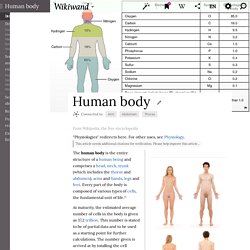
For other uses, see Physiology. This article needs additional citations for verification. Please help improve this article by adding citations to reliable sources. Unsourced material may be challenged and removed. (November 2013) Shoulder. Structures Bones Bone is living tissue that makes up the body's skeleton providing shape and support. The bones that form the shoulder are the clavicle, humerus, and scapula, the latter providing the glenoid cavity, acromion and coracoid processes. These three bones create a ball-and-socket glenohumeral joint, that gives the shoulder its wide range of motion in three different planes. Wrist. This article may be too technical for most readers to understand. Please help improve this article to make it understandable to non-experts, without removing the technical details. The talk page may contain suggestions. (June 2015) As a consequence of these various definitions, fractures to the carpal bones are referred to as carpal fractures, while fractures such as distal radius fracture are often considered fractures to the wrist. [5] Structure.
Leg. Structure In human anatomical terms, the leg is the part of the lower extremity that lies between the knee and the ankle, the thigh is between the hip and knee and the term "lower extremity" is used to describe the colloquial leg. This article generally follows the common usage. Comparison between human and gorilla skeletons. (Gorilla in non-natural stretched posture.) Evolution has provided the human body with two distinct features: the specialization of the upper limb for visually guided manipulation and the lower limb's development into a mechanism specifically adapted for efficient bipedal gait. Heel. The heel is the prominence at the posterior end of the foot. It is based on the projection of one bone, the calcaneus or heel bone, behind the articulation of the bones of the lower leg. Structure Sagittal section through the foot From above The Achilles tendon is the muscle tendon of the triceps surae, a "three-headed" group of muscles—the soleus and the two heads of the gastrocnemius.
Function Other animals. Toes. Structure The toe refers to a part of the human foot, with five toes present on each human foot. Ankle. Thigh. This article needs additional citations for verification. Please help improve this article by adding citations to reliable sources. Unsourced material may be challenged and removed. (April 2011) List of human anatomical features. This article may be too technical for most readers to understand. Please help improve this article to make it understandable to non-experts, without removing the technical details.
List of anatomical variations. Calf (leg) Forearm. This article needs additional citations for verification. Please help improve this article by adding citations to reliable sources. Knee. It is often grouped into tibiofemoral and patellofemoral components.[3][4] (The fibular collateral ligament is often considered with tibiofemoral components.)[5] Pain. Pain is a distressing feeling often caused by intense or damaging stimuli, such as stubbing a toe, burning a finger, putting alcohol on a cut, and bumping the "funny bone".[1] Because it is a complex, subjective phenomenon, defining pain has been a challenge. The International Association for the Study of Pain's widely used definition states: "Pain is an unpleasant sensory and emotional experience associated with actual or potential tissue damage, or described in terms of such damage. Morbid Anatomy. Back pain. Thoracic wall. Abdominal wall.
Wikiwand. Abdomen. Navel. The body. Body fat percentage. Body volume index. Waist-to-height ratio. Human reproductive system. Female reproductive system. Male reproductive system. Reproductive system. Waist–hip ratio. Neuroscience. Embarrassing Bodies from Channel 4, including Health Guides. About my brain. Human Body 2. Our Bodies. The Human Body & Anatomy. Buttocks. 6 Things Your Body Does Every Day That Science Can't Explain - Sharenator. Cymatics in the human body. Body + Human Body. The Body. Anatomy. THe Human Body Grade 5. The Human Body & Anatomy. 7 Big Myths About Body Fat. 10 Stubborn Body Myths That Just Won't Die, Debunked by Science. HowStuffWorks "Top 10 Brain Myths" Mind & Body. Body + Human Body. Head and neck anatomy.
Body proportions. Life Lists. Gray's Anatomy of the Human Body. Neutral spine. Sole (foot) All Stomach Muscles Anatomy And Abdominal Muscles Exercises. Historical Anatomies on the Web. Your Guide to the Human Body and Human Body Systems. Stomach. 3D Human Anatomy. Human leg. Google's Body Browser is a Google Earth for Human Physiology. Human physical appearance. Eye color. Human eye. Dream Anatomy: A National Library of Medicine Exhibit.